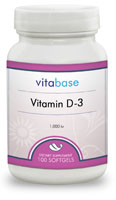| Cholecalciferol (vitamin D3) is a solid resin, with a molecular weight of 384.62. Vitamin D3 is the active & preferable form of vitamin D. It is a fat soluble vitamin & its absorption depends upon the presence of bile & fats in the intestines. Cholecalciferol is the most widely known of the vitamin D series and is a fat soluble vitamin that is stored to some degree in the body. Cholecalciferol is transferred to the liver where it is converted to calcifediol (25-hydroxycholecalciferol), which is then transferred to the kidneys and converted to calcitriol and 24,25-dihydroxycholecalciferol. Cholecalciferol and ergocalciferol are hydroxylated in the liver by the enzyme vitamin D 25-hydroxylase to form 25-hydroxycholecalciferol (calcifediol) and 25-hydroxyergocalciferol respectively.
Vitamin D3 can be produced photochemically by the action of sunlight or ultraviolet light from the precursor sterol 7-dehydrocholesterol which is present in the epidermis or skin of most higher animals. Vitamin D formed in this manner is termed "natural vitamin D" or vitamin D3. Vitamin D precursors obtained from milk and other products as well as sunlight-produced vitamin D must be metabolized in the liver to form the active coenzyme. Vitamin D3 is often thought to be the preferred vitamin because it has more biological activity. Vitamin D3 as found in food or in human skin always has various metabolites or isomers that may have biological benefit. There may be as many as 12 metabolites or isomers in the vitamin D found in animal foods. When vitamin D is taken in the form of fish oil, or eaten in foods such as eggs or fish, these metabolites will be present.
The primary functions of vitamin D are stimulation of calcium and magnesium absorption, two minerals that are essential for strong bones. Vitamin D3 is necessary for the ultilization of calcium and phosphorus, and for the assimilation of vitamin A. Cholecalciferol increases the serum calcium concentrations by increasing GI absorption of phosphorus and calcium, increasing osteoclastic resorption, and increasing distal renal tubular reabsorption of calcium. Proper levels are necessary to maintain bone mineral density and serum (blood) calcium levels. This is especially true among the very young where it is used to treat rickets and in combination with vitamin A for the treatment of osteoporosis in the elderly, particularly post menopausal women who are often subject to fractures due to loss of bone density.
Vitamin D3 is may exert a protective effect in multiple sclerosis - both in the development of the disease and in limiting its progression. Vitamin D3 also has a strong immune enhancing effect and controls blood pressure. Without sufficient levels of D3 in the blood, proper bone development and muscle contraction cannot take place. A Vitamin D3 deficiency will lead to serious medical conditions including malnutrition and metabolic bone disease. The latter may not show signs until a broken arm or leg occurs. Vitamin D3 functions more like a hormone than a vitamin because of the many cellular functions it affects. Many investigators already regard vitamin D as a hormone because of its sterol chemical structure & the fact that sunlight on your skin can use your body to make vitamin D. | 